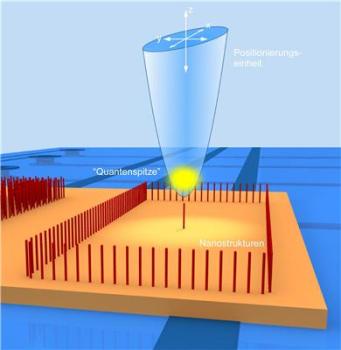The scanning probe microscope features an adjustable, suspended tip, which responds to minute height changes on the surface, and converts them into signals that can be displayed on a computer.
Tübingen researchers have developed this tip from a dilute gas of atoms that is ultra-cooled. To create this tip, they cooled pure gas of rubidium atoms to a temperature marginally above absolute zero and accumulated the cooled atoms in a magnetic trap.
 Cold-atom scanning probe microscopy
Cold-atom scanning probe microscopy
This “quantum tip” can be positioned accurately and enables evaluation of carbon nanostructures surfaces. It was possible to study the atom-surface interaction accurately and when the probe tip is cooled further, it forms the Bose-Einstein condensate, which improves the resolution of the microscope considerably. It is not possible to differentiate between atoms in the Bose-Einstein condensate. Since they form a “super-atom” individual freestanding nanotubes could be individually studied.
The scientists revealed how to use the cold-atom scanning probe tip by testing a surface with carbon nanotubes that were grown vertically. With the help of a magnetic conveyor belt, the tip was scanned over the surface of the sample. The initial measurements in the “contact mode” showed how the tall carbon nanotubes removed a few atoms from the atom cloud. Researchers could determine the exact height and position of the nanotubes using these atom losses. These atom losses also enabled researchers to produce images of the surface topography.
In the “dynamic mode” the condensate was made to oscillate at right angles to the surface and the variations in size and frequency respective to the nanostructured sample topography was observed. A clear resolved image of the surface was obtained. In this method there is no atom loss from the cloud.
The scientists claimed that future enhancements could increase the resolution of the cold-atom scanning probe microscope by eight µm by a factor of a thousand. The researchers also anticipate the development of new applications as a result of the coupling between nanostructures and ultra-cold quantum gases.